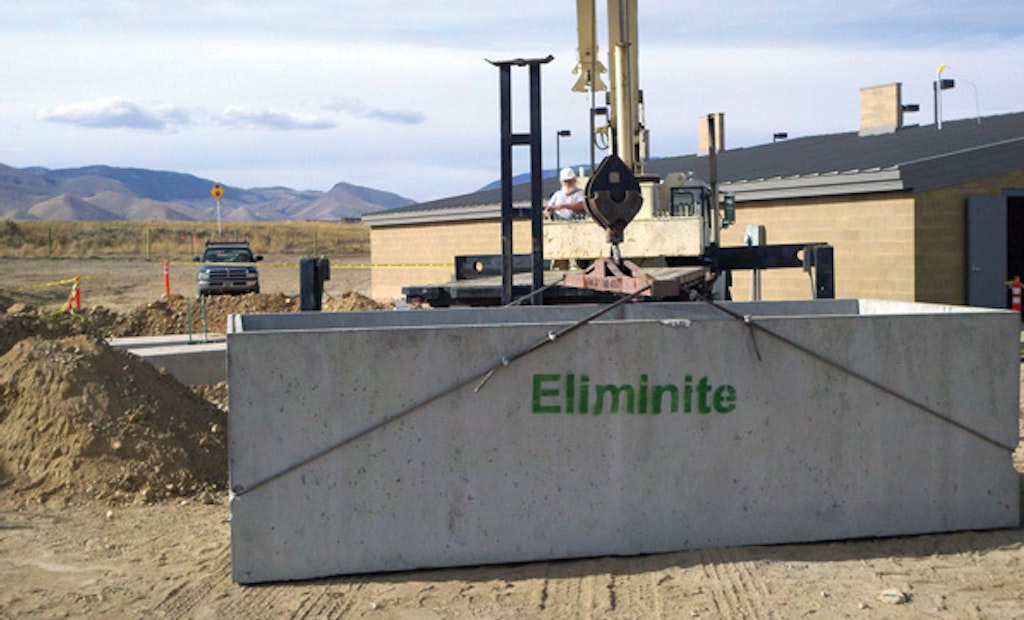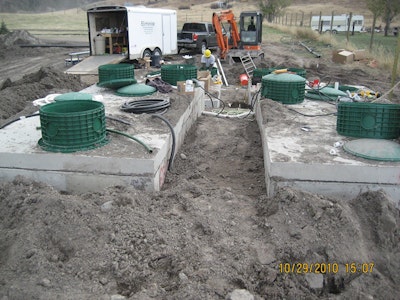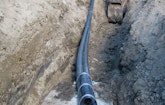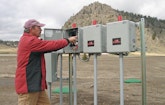
Interested in Systems/ATUs?
Get Systems/ATUs articles, news and videos right in your inbox! Sign up now.
Systems/ATUs + Get AlertsBlowing and drifting snow often closed stretches of Interstate 15 and mountain passes near Dearborn, Mont., backing up traffic to southbound and northbound rest areas.
The high-strength wastewater from these facilities’ two conventional onsite treatment systems had 180 to 250 mg/l total nitrogen (TN). Because the effluent numbers exceeded the state Department of Environmental Quality (DEQ) groundwater standards, officials suggested that the state Department of Transportation (DOT) research advanced treatment technologies.
The DOT published a request for proposals, specifying a DEQ-approved system to remove 60 percent TN. Eliminite in Three Forks, Mont., won the bid with a pre-engineered fixed-film bioreactor invented by Thomas Kallenbach, P.E., of Three Forks. His design consolidated the two systems into one behind the northbound rest area.
“The units easily achieved 40 to 50 percent TN reduction right out of the box in below-freezing temperatures,” says Kallenbach. To attain the required percent reduction, he added a separate nitrification/denitrification stage to control pH, as well as a carbon source. When the system went online in November 2010, effluent numbers displayed an immediate 80 percent reduction in TN.
Site conditions
Soils are fine sand and silt loam with a percolation rate of 30 minutes per inch. The water table is 20 feet below grade. The only suitable site for the drainfield was a natural bench with 6 to 8 percent slope on a hill with 15 percent slope.
System components
Kallenbach designed the system to handle 3,500 gpd. The major components are:
- Two 3,500-gallon dual-compartment concrete septic tanks, each with A100-8 effluent filter (Zabel, a product of Polylok). Precast tanks made by Three Forks Lumber and Ready-Mix and Flathead Concrete Products, Kalispell, Mont.
- Eliminite system of two 620 C bioreactors, each with two 24-inch Tuf-Tite risers and 1/2 hp Franklin discharge and recirculation pumps; and a 3,500-gallon dual-compartment polishing tank with 1/2 hp Franklin discharge pump.
- 2,000-gallon dosing tank with duplex 1/2 hp Hydromatic (Pentair) SHEF 50 discharge pumps.
- 960 feet of 2-inch pressurized pipe inside 220 36-inch Quick4 chambers (Infiltrator Systems). Pumps and piping supplied by Northwest Pipe Fittings Co., Great Falls, Mont.
- Siemens Logo control panel from SJE-Rhombus.
System operation
The septic, bioreactor, and polishing tanks are set in series. Wastewater from the southbound rest area flows under the freeway to the treatment train. Both laterals are 4-inch Schedule 40 PVC pipe plumbed to a septic tank. As effluent drains from the tanks to the bioreactors, small automatic feed pumps designed and built by Kallenbach monitor the flow and inject the appropriate amount of bicarbonate to control pH.
The bioreactors have a 9-foot-deep packed media bed that needs no cleaning or replacement. When the recirculation pump in the pump basin activates, it draws 150 gallons of effluent into a spray bar with four heads that evenly distributes it over 620 cubic feet of MetaRocks.
“MetaRocks are spheres of closed-cell polyurethane resins with three deep-contoured channels that provide large, open pores for passive air transfer,” says Kallenbach. “A coating of coarse sand and finely crushed recycled glass enables a thin liquid film to cover the entire surface and promote even, consistent growth of microorganisms.”
Nitrified liquid collects at the bottom of the tanks. Each time the recirculating pumps engage to dose the filters, they return a portion of the fluid through the denitrification lines to the septic tanks. When the rising liquid at the bottom of the tanks engages the float-activated discharge pumps in the pump basin, they each send 700 gallons to the polishing tanks.
A second set of automatic feed pumps injects a proprietary, environmentally safe carbon source into the first compartment of the polishing tanks. These post-anoxic denitrification chambers are upflow reactors.
“Liquid enters the bottom of the compartment, then flows up and over the dividing wall into the final carbon oxidation chamber,” says Kallenbach. “It removes excess carbon added to the flow by recirculating the water over 160 cubic feet of MetaRocks.”
When the water engages the float-activated discharge pumps, each sends 300 gallons to the dosing tank. Alternating pumps then deliver 700 gallons per dose through two 4-inch 160 psi DR 11 HDPE Schedule 40 force mains to the drainfield 3,000 feet away. The pipe diameter and material were necessary because of the distance.
Each half of the drainfield has a force main and central manifold feeding three 160-foot-long laterals on 7-foot centers. “The trenches are long because I wanted to keep them as close in elevation as possible,” says Kallenbach. He used Squirt, a pressurized drainfield design program, to analyze the hydraulics, as the elevation dropped 100 feet from the drainfield to the dosing tank.
“Because the force mains have so much capacity and are never full, the drainfield is always in a non-equilibrium state,” says Kallenbach. “There is a constant change in discharge rate with respect to head, which made the design far more complicated than most.” Orifices at the manifold lateral junctions control flows so each lateral receives an equal amount of water.
Installation
Work began in late October. Dick Anderson Construction of Helena, Mont., decommissioned the existing tanks and directional drilled under the freeway to run the 4-inch lateral from the southbound rest area. While excavating the 4-foot-deep tank holes, the crew hit undocumented ground water and ran a pump to stay ahead of it. They bedded the septic tanks on eight inches of compact 3/4-inch minus road base before backfilling with native material.
Instead of setting the treatment units in the water, foreman Frank Rask asked Kallenbach for permission to raise them to 30 inches and core drill a second inlet lower in the concrete tanks for the septic tanks’ plumbing. “That also made it easier to service the pumps, because now we used 18-inch instead of 48-inch risers,” says Kallenbach. Setting the tanks took a day and a half.
Workers fused the polyethylene pipes, then ran the force mains down the highway right-of-way and up the hill to the drainfield. They scarified the soil at the bottom of the 18-inch-deep trenches, laid the pressure piping after drilling 3/16-inch orifices five feet apart, and suspended the lines with plastic snap-tie fasteners inside the chambers.
At the bottom of each cleanout on the distribution piping, the crew installed a tee, ball valve, and 90-degree elbow. “Now when the service provider opens the valve, it flushes the lateral, but the discharge goes back into the trench instead of up onto the ground,” says Kallenbach.
Based on independent laboratory test results and the system’s reliability, the Federal Highway Administration issued a public interest finding designating Eliminite the sole source provider of advanced wastewater treatment systems for Montana DOT rest areas and facilities including maintenance shops, weigh stations and airports.
Maintenance
State regulations require the septic tanks to be pumped every five years and the effluent sampled annually. Kallenbach trained the DOT staff to draw samples and replace empty containers of carbon and bicarbonate.








